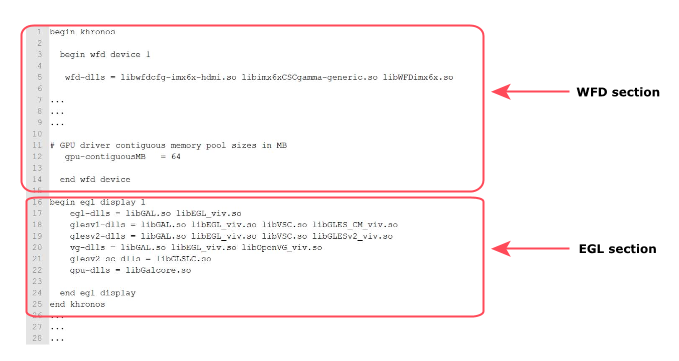Say that you have a splash screen application that runs on a NXP i.MX6 SABRE for Smart Devices Platform (SABRE Smart) board and the splash screen application is called splash screen_application.

Figure 1. Sample graphics.conf file for SABRE Smart board.
Board-specific memory allocator filename
...
alloc-config = imx6xbuf
...
Therefore, the name of the memory allocator file is screen-imx6xbuf.so because the value is prefixed with screen- and suffixed with .so.Board-specific Screen libraries that must be loaded in the primary IFS
- libwfdcfg-imx6x-hdmi.so
- libimx6xCSCgamma-generic.so
- libWFDimx6x.so
Summary of minimum files required for Screen
The following table summarizes the minimum files required to show content on the display:| File | Purpose |
|---|---|
| graphics.conf | The Screen service configuration file |
| csc_gamma.conf | Configuration file for CSC gamma |
| libwfdcfg-imx6x-hdmi.so | The HDMI device driver |
| libimx6xCSCgamma-generic.so | Generic board CSC Gamma library |
| libWFDimx6x.so | Generic board WFD library |
libscrmem.so libmemobj.so |
Memory manager for Screen |
| libWFD.so | Driver for WFD |
| screen-imx6xbuf.so | The library to allocate buffers |
| libscreen.so | The Screen library |
Summary of splash screen application files
Since the splash screen application shows a PNG image (static image), these are the application-specific libraries for our example:
| File | Purpose |
|---|---|
| splash_screen_application | Your splash screen application, which you create |
| img_codec_png.so | The codec required to show an image |
| libimg.so | The Image library to render an image |
| img.conf | The configuration file to configure the codec for the Image library |
| splash screen_application.png | The static graphic (content) to show on the display |
Board-specific Screen libraries that can be loaded later
The candidate files that can be loaded in the secondary IFS or a filesystem are listed in the EGL section of the graphics.conf file for your board. To improve the startup time for Screen, we recommend that you put these files in the secondary IFS if you need them loaded into memory. If you put any of the files in your primary IFS, you will risk increasing the startup time of your system because it can significantly increase the size of the primary IFS.
- libGAL.so
- libEGL_viv.so
- libVSC.so
- libGLES_CM_viv.so
- libGLESv2_viv.so
- libOpenVG_viv.so
- libGLSLC.so
- libGalcore.so